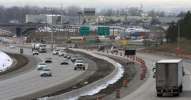This is an archived article that was published on sltrib.com in 2009, and information in the article may be outdated. It is provided only for personal research purposes and may not be reprinted.
Salt Lake City's Interstate 80 construction zone has been a champion speed trap for 14 months, dealing out nearly 3,000 tickets since the state started patrolling it with extra troopers.
It's a sustained crackdown that troopers say slowed traffic and reduced accidents, though it remains to be seen whether a cost-cutting reduction in enforcement this month will reverse the trend.
The Utah Department of Transportation has paid $8,000 to $10,000 a month in overtime to the Utah Highway Patrol to catch speeders between State Street and 1300 East since late March 2008. That covered 70 six-hour shifts a month, Sgt. Jeff Nigbur said, and the officers had issued 2,999 tickets as of Monday afternoon.
The crash rate also has dropped by about half, Nigbur said. "When you have four troopers working that corridor and they all have cars stopped, people will slow down."
But the extra help -- the only of its kind right now in a Utah highway work zone -- is thinning this month. As the I-80 widening project moves toward completion later this year, UDOT has cut the policing budget to $2,000 a month. That's enough overtime, Nigbur said, for 10 extra five-hour shifts a month on the freeway.
UDOT paid for the extra patrols after some well-publicized crashes involving trucks and rollovers in the work zone in January 2008. At the time, the state found drivers were averaging 72 mph in the 55 mph work zone.
The additional fines don't go to the state or back into UDOT's work-zone patrols, but to the city where the motorists are pulled over.
Those flashing lights are comforting to workers, said Wayne Bowden, project manager of Ralph Wadsworth Construction, although the problem isn't solved.
"People do still speed through the corridor," he said, "and it's dangerous for our employees."
At this point, a concrete barrier separates most workers from traffic, though there are missing links where construction trucks move in and out of the work zone from the freeway. Speeders, Bowden said, are especially dangerous to the slower-moving construction vehicles using those portals.
"We've got an average of 400 vehicles that go in and out of these entrances. When people are clipping along at 80 mph it's very dangerous," he said. "We've had a couple of fender benders with people going too fast."
Earlier in the project, workers used a movable barrier to allow for an extra lane in the direction of peak travel, depending on the hour. Now all traffic runs on what will become the eastbound lanes, and there are three lanes in each direction. Bowden believes the new, smoother and wider lanes on that side have helped reduce accidents.
"We're still having speeders out there, and it just goes to show that we need to have that partnership," UDOT spokesman Adan Carrillo said. "We need to have enforcement."
Although the department has cut its enforcement budget as the project winds down, Carrillo said, it could boost spending again if problems increase before completion this winter.
bloomis@sltrib.com" Target="_BLANK">bloomis@sltrib.com
1-10 mph over » $100.
11-15 mph over » $150.
16-20 mph over » $250.
21-25 mph over » $400.
26-30 mph over » $600.
31-plus mph over » $800 plus $52 per additional mph.
Source: UDOT



